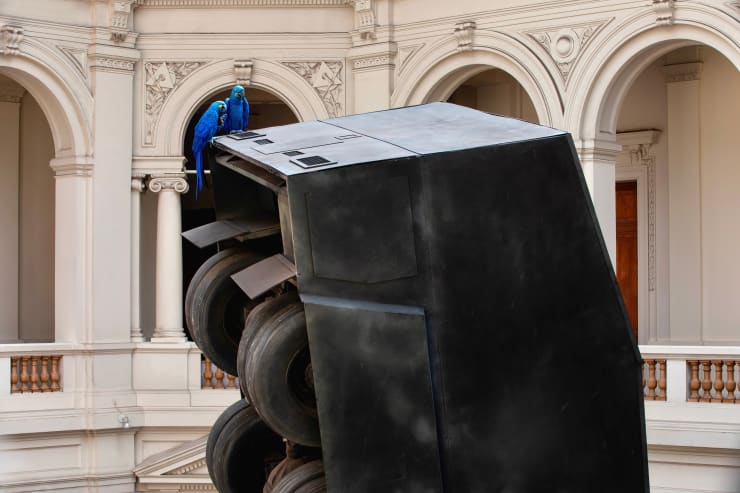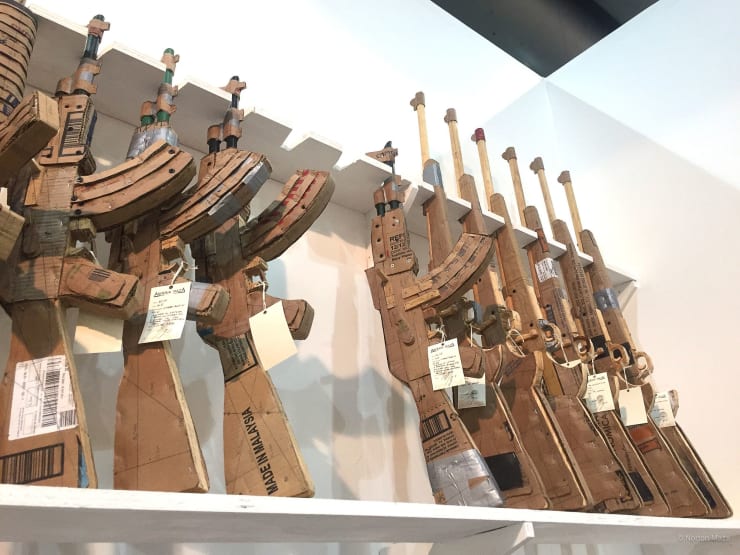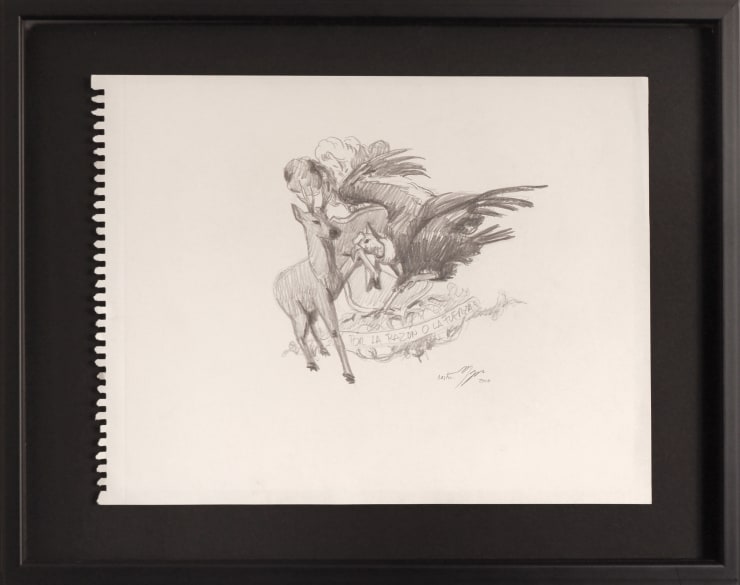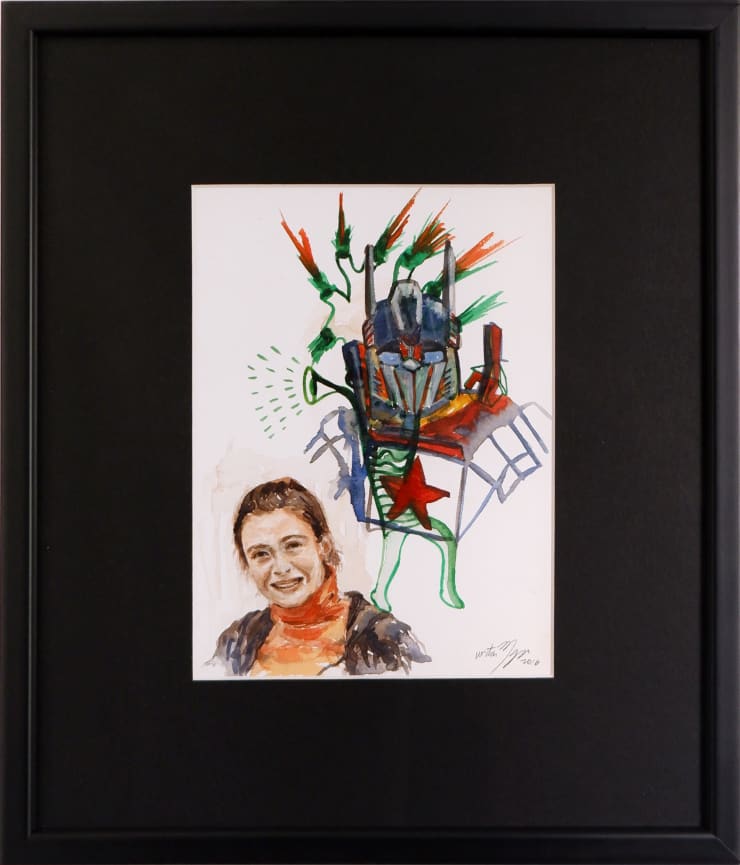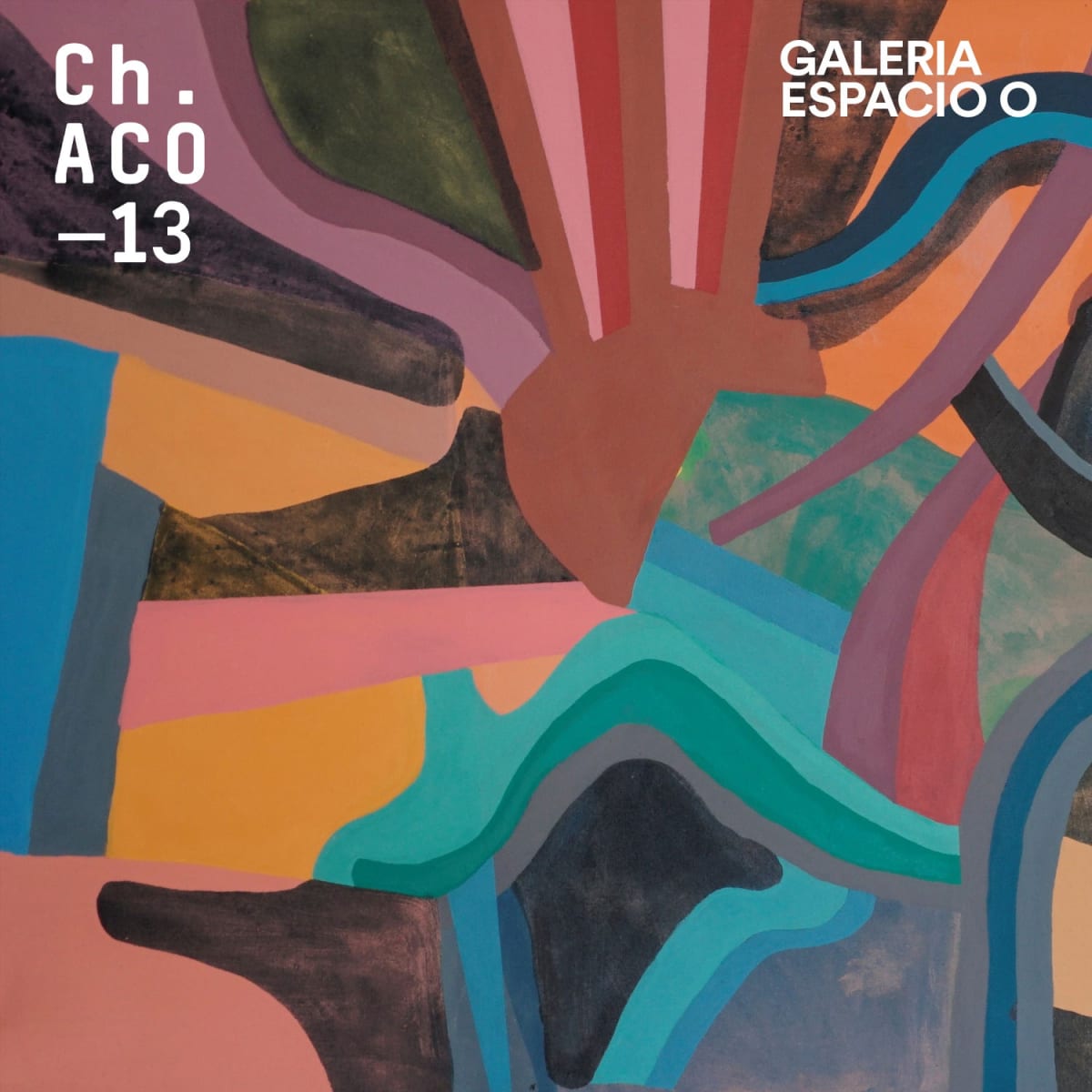Norton Maza Chilean, b. 1971
The artist explores the socio-cultural and political contrasts shaped by globalization. His highly committed work ironically and with unparalleled sensitivity encompasses the explicitly raw and emotional reality he must interact with.
Visual artist Norton Maza began his art studies in Havana (Cuba), first at the Juan Pablo Duarte Elementary School and then at the National School of Art. He continued his higher education in art at the School of Fine Arts in Bordeaux (France).
He has exhibited his work in places such as the National Museum of Fine Arts (Santiago, Chile), Quinta Normal Museum of Contemporary Art (Santiago, Chile), Museum of Contemporary Art MAC (Santiago, Chile), Modern Art Museum of Chiloé MAM (Castro, Chile), Salvador Allende Solidarity Museum (Santiago, Chile), Ignacio Agramonte Museum (Camagüey, Cuba), Terrasson Cultural Center (Terrasson, France), Le Creux de l'Enfer Contemporary Art Center (Thiers, France), Les Treize Arches (Brive la Gaillarde, France), Matta Cultural Center (Buenos Aires, Argentina), MUSA Museum (Guadalajara, Mexico), Patricia Ready Gallery (Santiago, Chile), Gabriela Mistral Gallery (Santiago, Chile), Bendana Pinel Art Contemporain Gallery (Paris, France), YAM Gallery (San Miguel de Allende, Mexico), among others.
The artist lives and works in Santiago, Chile.
-
 Norton MazaHistorias de un lugar, 2023Oil on canvas120 x 120 cm$USD 6,000.00
Norton MazaHistorias de un lugar, 2023Oil on canvas120 x 120 cm$USD 6,000.00 -
 Norton MazaLa Necesidad de jugar - Camioneta 4x4 (The need to play - 4x4 Truck), 2023Plastic and wood truck43,5 x 23 x 29 cm$USD 3,500.00
Norton MazaLa Necesidad de jugar - Camioneta 4x4 (The need to play - 4x4 Truck), 2023Plastic and wood truck43,5 x 23 x 29 cm$USD 3,500.00 -
 Norton MazaLa Necesidad de jugar - Jeep (The need to play - Jeep), 2023Palstic and wood jeep$USD 3,500.00
Norton MazaLa Necesidad de jugar - Jeep (The need to play - Jeep), 2023Palstic and wood jeep$USD 3,500.00 -
 Norton MazaLa Necesidad de jugar - Jeep Tonka (The need to play - Tonka Jeep), 2023Metal and wood jeep44,5 x 25,5 x 23 cm$USD 3,500.00
Norton MazaLa Necesidad de jugar - Jeep Tonka (The need to play - Tonka Jeep), 2023Metal and wood jeep44,5 x 25,5 x 23 cm$USD 3,500.00 -
 Norton MazaLa Necesidad de jugar - Televisor (the need to play - TV), 2023Plastic and wood television$USD 3,500.00
Norton MazaLa Necesidad de jugar - Televisor (the need to play - TV), 2023Plastic and wood television$USD 3,500.00 -
 Norton MazaLa Necesidad de jugar - Tren (The need to play - Train), 2023Plastic and wood train$USD 3,500.00
Norton MazaLa Necesidad de jugar - Tren (The need to play - Train), 2023Plastic and wood train$USD 3,500.00 -
 Norton MazaAnalogías de la realidad I (Analogies of reality No. 1), 2022Photography of installation documentation. Epson Digigraphite printing on 310 g cotton paper.78 x 110 cm$USD 1,300.00
Norton MazaAnalogías de la realidad I (Analogies of reality No. 1), 2022Photography of installation documentation. Epson Digigraphite printing on 310 g cotton paper.78 x 110 cm$USD 1,300.00 -
 Norton MazaAnalogías de la realidad II (Analogies of reality No. 2), 2022Photography of installation documentation. Epson Digigraphite printing on 310 g cotton paper.110 x 78 cm$USD 1,300.00
Norton MazaAnalogías de la realidad II (Analogies of reality No. 2), 2022Photography of installation documentation. Epson Digigraphite printing on 310 g cotton paper.110 x 78 cm$USD 1,300.00 -
 Norton MazaAnalogías de la realidad III (Analogies of reality No. 3), 2022Photography of installation documentation. Epson Digigraphite printing on 310 g cotton paper.78 x 110 cm$USD 1,300.00
Norton MazaAnalogías de la realidad III (Analogies of reality No. 3), 2022Photography of installation documentation. Epson Digigraphite printing on 310 g cotton paper.78 x 110 cm$USD 1,300.00 -
 Norton MazaFragmentos de un impacto, 2021EsculturaMedidas variabesSold
Norton MazaFragmentos de un impacto, 2021EsculturaMedidas variabesSold -
 Norton MazaBreak AK-47 (real scale), 2018AK-47 assault rifles made from different materials such as cardboard, wood, PVC pipes, adhesive tape, etc.Real Scale$USD 2,000.00
Norton MazaBreak AK-47 (real scale), 2018AK-47 assault rifles made from different materials such as cardboard, wood, PVC pipes, adhesive tape, etc.Real Scale$USD 2,000.00 -
 Norton MazaBreak M16 (real scale), 2018M16 assault rifles made from different materials such as cardboard, wood, PVC pipes, adhesive tape, etc.Real Scale$USD 2,500.00
Norton MazaBreak M16 (real scale), 2018M16 assault rifles made from different materials such as cardboard, wood, PVC pipes, adhesive tape, etc.Real Scale$USD 2,500.00 -
 Norton MazaEl Rapto (The Abduction), 2016Resin, polychrome fiberglass and bronze.Actual scale
Norton MazaEl Rapto (The Abduction), 2016Resin, polychrome fiberglass and bronze.Actual scale -
 Norton MazaEstudio II (Study II), 2016Watercolor on paper34 x 28 cm$USD 850.00
Norton MazaEstudio II (Study II), 2016Watercolor on paper34 x 28 cm$USD 850.00 -
 Norton MazaEstudio III (Study III), 2016Graphite on paper35 x 43 cmSold
Norton MazaEstudio III (Study III), 2016Graphite on paper35 x 43 cmSold -
 Norton MazaGárgola de la obra El Rapto (Gargoyle from The Rapture), 2016Aluminum using lost wax technique
Norton MazaGárgola de la obra El Rapto (Gargoyle from The Rapture), 2016Aluminum using lost wax technique
(only 3 available)18.5 x 31 x 25 cm$USD 2,700.00 -
 Norton MazaEstudio I (Study I), 2015Watercolor on paper34 x 28 cm$USD 850.00
Norton MazaEstudio I (Study I), 2015Watercolor on paper34 x 28 cm$USD 850.00 -
 Norton MazaBreak AK-47, 2013-2024AK-47 assault rifles made from different materials such as cardboard, wood, PVC pipes, adhesive tape, etc.250 cm long$USD 4,000.00
Norton MazaBreak AK-47, 2013-2024AK-47 assault rifles made from different materials such as cardboard, wood, PVC pipes, adhesive tape, etc.250 cm long$USD 4,000.00 -
 Norton MazaBreak M16, 2013-2024M16 assault rifles made from different materials such as cardboard, wood, PVC pipes, adhesive tape, etc.250 cm long$USD 4,500.00
Norton MazaBreak M16, 2013-2024M16 assault rifles made from different materials such as cardboard, wood, PVC pipes, adhesive tape, etc.250 cm long$USD 4,500.00 -
 Norton MazaCristo - Del paisaje y sus reinos (Christ - Of the landscape and its kingdoms), 2013Resin and polychrome fiberglassHuman scaleSold
Norton MazaCristo - Del paisaje y sus reinos (Christ - Of the landscape and its kingdoms), 2013Resin and polychrome fiberglassHuman scaleSold -
 Norton MazaCristo Pequeño- Del paisaje y sus reinos (Little Christ - Of the landscape and its kingdoms), 2013Resin and polychrome fiberglass (The work includes the glass dome)85 x 60 x 97 cm
Norton MazaCristo Pequeño- Del paisaje y sus reinos (Little Christ - Of the landscape and its kingdoms), 2013Resin and polychrome fiberglass (The work includes the glass dome)85 x 60 x 97 cm -
 Norton MazaEspejo - Del paisaje y sus reinos (Mirror - Of the landscape and its kingdoms), 2013Resin and polychrome fiberglass195 x 130 cmSold
Norton MazaEspejo - Del paisaje y sus reinos (Mirror - Of the landscape and its kingdoms), 2013Resin and polychrome fiberglass195 x 130 cmSold -
 Norton MazaVirgen - Del paisaje y sus reinos (Virgin - Of the landscape and its kingdoms),, 2013Resin and polychrome fiberglass85 x 85 x 65 cm
Norton MazaVirgen - Del paisaje y sus reinos (Virgin - Of the landscape and its kingdoms),, 2013Resin and polychrome fiberglass85 x 85 x 65 cm -
 Norton MazaEl Callejón del Monopolio (Monopoly Alley), 2007Analog photography of dioramas. Epson Digigraphite printing on 310 g cotton paper.34 x 34 cm$USD 1,200.00
Norton MazaEl Callejón del Monopolio (Monopoly Alley), 2007Analog photography of dioramas. Epson Digigraphite printing on 310 g cotton paper.34 x 34 cm$USD 1,200.00 -
 Norton MazaEl Hombre en su Átomo (Man in his Atom), 2007Analog photography of dioramas. Epson Digigraphite printing on 310 g cotton paper.34 x 34 cm$USD 1,200.00
Norton MazaEl Hombre en su Átomo (Man in his Atom), 2007Analog photography of dioramas. Epson Digigraphite printing on 310 g cotton paper.34 x 34 cm$USD 1,200.00 -
 Norton MazaEl Mundo de los Sueños (The world of dreams), 2007Analog photography of dioramas. Epson Digigraphite printing on 310 g cotton paper.34 x 45 cm$USD 1,200.00
Norton MazaEl Mundo de los Sueños (The world of dreams), 2007Analog photography of dioramas. Epson Digigraphite printing on 310 g cotton paper.34 x 45 cm$USD 1,200.00 -
 Norton MazaLa Caída del Orden (The Fall of Order), 2007Analog photography of dioramas. Epson Digigraphite printing on 310 g cotton paper.44 x 34 cm$USD 1,200.00
Norton MazaLa Caída del Orden (The Fall of Order), 2007Analog photography of dioramas. Epson Digigraphite printing on 310 g cotton paper.44 x 34 cm$USD 1,200.00 -
 Norton MazaLa Cocinera (The Cook), 2007Analog photography of dioramas. Epson Digigraphite printing on 310 g cotton paper.34 x 38,5 cm$USD 1,200.00
Norton MazaLa Cocinera (The Cook), 2007Analog photography of dioramas. Epson Digigraphite printing on 310 g cotton paper.34 x 38,5 cm$USD 1,200.00 -
 Norton MazaLa junta de la decadencia (The board of decay), 2007Analog photography of dioramas. Epson Digigraphite printing on 310 g cotton paper.34 x 52,5 cm$USD 1,200.00
Norton MazaLa junta de la decadencia (The board of decay), 2007Analog photography of dioramas. Epson Digigraphite printing on 310 g cotton paper.34 x 52,5 cm$USD 1,200.00 -
 Norton MazaObra Final (Final Work), 2007Analog photography of dioramas. Epson Digigraphite printing on 310 g cotton paper.34 x 51 cm$USD 1,200.00
Norton MazaObra Final (Final Work), 2007Analog photography of dioramas. Epson Digigraphite printing on 310 g cotton paper.34 x 51 cm$USD 1,200.00 -
 Norton MazaLa Avalancha del Caos (The Avalanche of Chaos), 2006Analog photography of dioramas. Epson Digigraphite printing on 310 g cotton paper.34 x 42 cm$USD 1,200.00
Norton MazaLa Avalancha del Caos (The Avalanche of Chaos), 2006Analog photography of dioramas. Epson Digigraphite printing on 310 g cotton paper.34 x 42 cm$USD 1,200.00
This text can only be read one way: from left to right. However, Norton Maza's work can be understood from various perspectives, whether considering its intersections with history, sociology, biography, politics, or art. It is not cryptic but critical.
Critical of power. Ecclesiastical, economic, state power. Power understood as an oppressive, overbearing entity. It generates not a call to action but to reflection. Not through reproduction but representation. Placing the viewer in an uncomfortable location, nestled on a couch of prejudices, certainties that enter into crisis. The visitor to a work, a scenography by Norton Maza, is part of it, immerses themselves in the artist's imagination. In this position, the viewer questions the work and questions themselves.
First a grimace, then a smile, a laugh, and finally a burst of laughter. In the face of luxury, elitism. In the museum, under a colonial-style backdrop, the hubbub is heard on the mezzanine, the transition between the hidden and the venerated, and murmurs abound in the basement, the dirty conscience of the temple.
The game. From the first rudimentary toys constructed by Maza, an artist who coexists between the first and third worlds, to conceptual games in which we are the toys in the hands of power.
The dirty, the clean. Many of the works display this double aspect: an idyllic, shiny world constructed with visible discarded materials. There's a trap, there's cardboard. The artist employs an openly diverse range of resources to convey his messages. Ideas that surprise us, ridicule us, satirize us, and reflect us.
JUAN JOSÉ SANTOS - Curator and art critic
-

Albergue Transitorio
Exposición Colectiva 3 Dec 2025 - 28 Feb 2026Exposición colectiva que alberga obras de nuestros artistas representados y en colaboración: Colectivo Hipermercado Casino, Alfredo Da Venezia, Daniela Claro, César Gabler, Virginia Guilisasti, Fernanda Gutiérrez, Sebastián Leyton, Pascual Ovalle,...Read more -

Comenzar con una idea
Group Exhibition 15 Apr - 10 Jun 2023Espacio O Gallery is embarking on a new phase with a new space in the neighborhood where it was born, the Lastarria Neighborhood. The exhibition with which they are inaugurating...Read more -

Todo tiempo pasado fue
Group Exhibition 30 Sep - 3 Oct 2021Artistas de la muestra colectiva: Norton Maza, Alfredo Da Venezia, Bruna Truffa, Sebastián Leyton, Virginia Guilisasti, Colectivo Hipermercado Casino, Ciro Beltrán, Armando de la Garza y Fernanda Gutiérrez. En un...Read more









